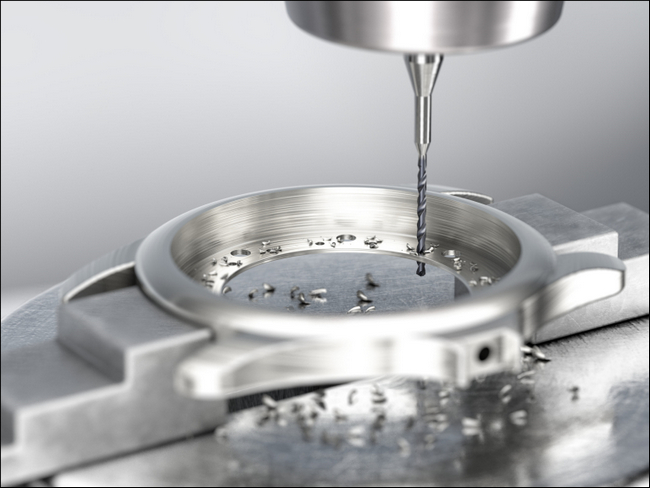Polycrystalline diamond (PCD) veined CoroDrill® 862 micro drill offers way forward for manufacturers
Can luxury watchmaking go green? While there’s a growing onus on watchmakers to be more sustainable, they must also fashion masterpieces of micro engineering from some of the world’s toughest materials, like ceramics. But these materials can cause serious issues with regards to tool life. Here, James Thorpe, global product manager at the leader in metal cutting Sandvik Coromant, explains how advanced tools including its CoroDrill® 862 micro drills can give enhanced wear resistance for more sustainable production.
Perhaps the most extreme recent example of sustainable watchmaking is the so-called Garbage Watch by Vollebak, a radical design-led British clothing brand that makes clothes and accessories using emerging materials, with new technologies and processes. Vollebak says its products are “of the future” while also being sustainable. Despite its name, the Garbage Watch is a coveted made-to-order item that has featured in the world’s top design publications.
“I thought, you must be able to build a watch out of e-waste,” Vollebak co-founder Nick Tidball told Esquire magazine earlier this year. Esquire’s article mentions findings from the UN’s Global E-waste Monitor report that a record 54 million tonnes of electronic waste was generated by all industries globally in 2019, which was up 21% in five years. Precious metals with a value of $1.7 billion were recovered from this e-waste, but this was only 17% of the total recyclable amount. The overall value of the precious metals would have been closer to $10 billion.
 Ceramics are tough to machine but increasingly used in all-black luxury watches.
Ceramics are tough to machine but increasingly used in all-black luxury watches.
This figure shows how far industry is falling behind in making full use of recyclable e-waste. But steps are being made to rectify this, including by watch manufacturers. Let’s look at another e-waste material, ceramics — solid compounds that consist largely of inorganic and non-metallic components bound by strong chemical bonds. They are fully-recyclable and are becoming more popular among watch designers. According to SwissWatchExpo, advantages of ceramics include their exceptional hardness, especially when compared to steel and gold, and they are a good material for all-black watches which continue to gain popularity.
But ceramics are often very difficult to machine. As confirmed by a study by the Department of Mechanical Engineering at the BMS College of Engineering in Karnataka, India: “Machining of ceramics is also plagued by surface damage, excessive tool wear, and edge chipping when machined using conventional techniques.” It continues: “Non-conventional techniques such as electric discharge machining (EDM) and abrasive water jet machining are characterized by poor surface finish and excessive occurrence of pits, respectively.”
BMS College’s report identifies achieving dimensional accuracy and minimizing collateral damage, such as surface cracks, as the main challenges of machining ceramics — and neither obstacle is conducive to sustainable manufacturing. How can watchmakers overcome these challenges?
Drilling ceramics
The answer lies in more wear-resistant tools. Sandvik Coromant has evolved its tool offering by introducing two new micro drill families to its product range, CoroDrill® 462 with -XM geometry and CoroDrill® 862 with -GM geometry, which each offer a wide range of cutting diameters and lengths. Both tools are designed to be ideal for precision machining in industries dealing with small parts, while also offering more sustainable performance.
In particular, each tool is designed to offer superior wear resistant properties that deliver outstanding performance with challenging materials within all ISO applications areas, including ISO P, M, K, N, S, O and H. This is further enhanced by the option of purchasing the micro dill with a polycrystalline diamond (PCD) vein cutting edge. Based on successful tests of PCD drills on micro parts made from platinum, Sandvik Coromant has found that PCD is up to 100 times more wear resistant than solid carbide and, in addition, is more accurate and can produce tighter tolerances than solid carbide tools.
The tools are also suitable for machining ceramics and semi-fired ceramics. In one test, a Sandvik Coromant CoroDrill® 862 tool with a veined PCD cutting edge was used in a horizontal machining centre to drill 8.38 mm (0.330 inch) deep blind holes in an alumina ceramic workpiece, a fine ceramic material well-known for its chemical and physical stability, with no pecking. The tool was run at a diameter (Dc) of 1.70 mm (0.067 inches), a cutting speed (vc) of 53 m/min (174 ft/min) and feed rate (fn) of 0.025 mm/z (00.001 in/z).
 Sandvik Coromant’s CoroDrill® 862 with -GM geometry can be further enhanced with a PCD vein cutting edge.
Sandvik Coromant’s CoroDrill® 862 with -GM geometry can be further enhanced with a PCD vein cutting edge.
In the end, 933 holes were drilled and the hole quality and tool life were both excellent. Aside from these results, the key takeaway is the lifecycle advantages of CoroDrill® 862 micro drill. Customers can achieve longer-lasting, reliable and predictable performance that better-complements the plant’s sustainability strategy. Sandvik Coromant’s engineers also recommend PCD to those seeking to drill micro-sized holes in notoriously difficult-to-machine materials, such as titanium, aluminium, glass and also ceramics.
As with macroscale applications, the importance of coolant must also be considered in microscale applications like watchmaking. It’s critical to have quality coolant delivery to effectively evacuate chips when performing deep-hole drilling with micro tools.
The features and performance of veined PCD for extended tool life, are shown to overcome the machining challenges posed by tough materials like ceramics. Sandvik Coromant’s expanded CoroDrill® family of tools show that more productive and sustainable production processes are available, and can help contribute towards a greener future for watchmakers.
Sandvik Coromant
Part of global industrial engineering group Sandvik, Sandvik Coromant is at the forefront of manufacturing tools, machining solutions and knowledge that drive industry standards and innovations demanded by the metalworking industry now and into the next industrial era. Educational support, extensive R&D investment and strong customer partnerships ensure the development of machining technologies that change, lead and drive the future of manufacturing. Sandvik Coromant owns over 1700 patents worldwide, employs over 7,700 staff, and is represented in 150 countries.
For more information visit www.sandvik.coromant.com
